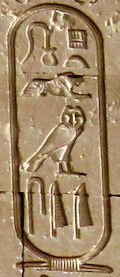There are three main types of hieroglyph. The hieroglyphic language is based on the phonetic value(s) of the hieroglyph, with extra information conveyed by hieroglyphs acting as logograms and determinatives. However, one hieroglyphic sign may act as a logogram, a phonogram, or a determinative depending on the situation.
The convention in translation is to “transliterate” (turn the hieroglyph into their phonetic values) and then confirm the meaning with reference to the non-phonetic elements of the word (determinatives and logograms). This sounds really complicated, but you will quickly get the hang of it if you persevere, and it makes vocabulary much easier to remember.
Phonograms
A phonogram indicates one or more sounds (or syllables). Phonograms are uni-consonantal, bi-consonantal or tri-consonantal. The uni-consonontal signs (below) are commonly used in personal names. The Pharaohs names tended to be made up of more complex signs and often featured the name of a god, but during the Old Kingdom and Ptolemaic period the Pharaohs spelled their names phonetically using single consonant signs.
For example;

t

h

f

p

The cartouche on the left depicts the name Ptolemy (in this case, Ptolemy son of Cleopatra VII).
It reads right to left, and top to bottom as;
p – t – o – l – m – y – s
Most Egyptian words used a combination of single, double and triple consonant signs.
Logograms
A logogram (or ideogram) represents an entire word. Many logograms are also phonograms (they have a sound value rather than representing a whole word). If the sign is intended to act as a logogram, there is usually a vertical line beneath it. For example, sign for the letter “r” becomes the sign for word “mouth” when written with a vertical line (indicating it is a logogram).

“r”

“mouth”
Determinatives
The determinative has no phonetic value, and so is not transliterated. It indicates the end of the word and provides you with further information concerning the meaning of the word. The determinative sign can be vital for translation as there are no vowels in hieroglyphics, and so a set of consonants could have more than one meaning. For example, the sound “hD” (hedj) can represent the metal silver or the colour white.

hdj (silver)

hdj (white)
To prevent any confusion the determinatives of a collar necklace (representing gold and used here because silver was called “white gold”) and three grains of sand (representing a mineral) were added when the scribe was referring to silver. The determinative of a sun was used to indicate that the correct translation was “white”. The sign of the snake in “white” is a phonetic complement for the sound “dj”. It is not pronounced separately.
Likewise, “iAw” (iahu) can represent the word “old” or the verb “to praise” with the determinative of an old man leaning on a stick or a man raising his arms in praise to make it clear which meaning is intended. In monumental scenes, the determinative is sometimes omitted as the context makes it clear how the word should be translated.

iahw (old)

iahw (praise)
There are many determinatives, and it is useful to be able to recognise some of the most common ones.

Hieroglyphs Resources
- Gardiner’s sign list
- Single consonant signs
- Phonograms, Logograms and Determinatives
- Nouns and Prepositions
- Relative Forms
- Pronouns
- Word Order
- Verbs forms
- Past and Present tense
Copyright J Hill 2010